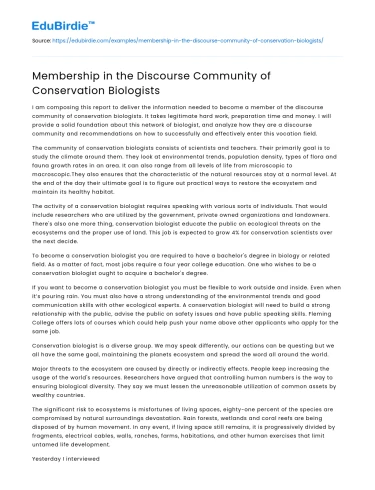Introduction
The discourse community of conservation biologists is a unique and dynamic collective that plays a pivotal role in safeguarding biodiversity in a rapidly changing world. This community is defined by shared goals, specialized knowledge, and a commitment to preserving the natural environment through research, policy advocacy, and public education. Membership in this community involves not only technical expertise but also active participation in dialogues that shape conservation strategies and policies. The significance of this community is underscored by the increasing threats to biodiversity, such as habitat loss, climate change, and species extinction. As such, conservation biologists are at the forefront of interdisciplinary efforts to develop sustainable solutions. This essay explores the characteristics of the conservation biology discourse community, the roles and responsibilities of its members, and the challenges they face. Additionally, it addresses opposing viewpoints to highlight the multifaceted nature of conservation biology and its impact on global environmental policy.
Characteristics of the Conservation Biology Discourse Community
Conservation biology is a field characterized by its interdisciplinary approach, integrating principles from ecology, genetics, environmental science, and social sciences. Members of this discourse community possess a shared lexicon that includes terms like "biodiversity," "ecosystem services," and "adaptive management." According to a study by Meffe et al. (2006), effective communication within this community is facilitated by a common understanding of these concepts, which enables collaboration across diverse scientific disciplines. Moreover, conservation biologists often engage in collaborative research projects, contributing to a collective body of knowledge that informs conservation practices and policy development. A notable example is the collaborative efforts to conserve the critically endangered Amur Leopard, which involved international partnerships and shared data to implement effective conservation strategies.
Save your time!
We can take care of your essay
- Proper editing and formatting
- Free revision, title page, and bibliography
- Flexible prices and money-back guarantee
Another defining characteristic of this community is its commitment to ethical considerations in conservation practices. The Society for Conservation Biology, a leading organization in this field, emphasizes the importance of ethical standards in conducting research and implementing conservation measures. This commitment is reflected in the community's focus on promoting equity and inclusivity in conservation efforts, as highlighted by Redford and Adams (2009), who argue for the integration of local and indigenous knowledge systems into conservation practices. By acknowledging these diverse perspectives, the conservation biology discourse community strives to address the complex socio-economic and cultural factors that influence conservation outcomes.
Roles and Responsibilities of Conservation Biologists
Conservation biologists play a crucial role in advancing scientific research and translating findings into actionable policies. Their responsibilities extend beyond conducting field studies to include public education and policy advocacy. For instance, conservation biologists contributed significantly to the establishment of marine protected areas by providing scientific evidence on the benefits of habitat protection for marine biodiversity. These efforts are often communicated through scientific publications, conferences, and policy briefs, which serve as platforms for disseminating research findings and influencing decision-makers.
In addition to research and advocacy, conservation biologists are tasked with developing innovative solutions to address emerging environmental challenges. This involves the application of cutting-edge technologies such as remote sensing and genetic analysis to monitor and manage biodiversity. A case in point is the use of environmental DNA (eDNA) in monitoring aquatic ecosystems, which offers a non-invasive method for detecting species presence and assessing ecosystem health. By leveraging such technologies, conservation biologists enhance their capacity to respond to ecological changes and contribute to adaptive management strategies.
Despite these contributions, conservation biologists face numerous challenges, including limited funding, political resistance, and conflicts with economic interests. These challenges necessitate resilience and adaptability, as highlighted by Kareiva and Marvier (2012), who emphasize the importance of building partnerships with stakeholders across sectors to achieve conservation goals. By engaging with diverse audiences, conservation biologists can foster a broader understanding of the importance of biodiversity conservation and garner support for their initiatives.
Challenges and Counterarguments
While the conservation biology discourse community is instrumental in shaping environmental policies, it is not without its critics. One common counterargument is the perceived prioritization of scientific knowledge over local and indigenous knowledge systems. Critics argue that this can lead to the marginalization of communities that have historically coexisted with natural ecosystems. To address this concern, conservation biologists are increasingly advocating for participatory approaches that involve local communities in decision-making processes. This shift is exemplified by community-based conservation initiatives that empower local stakeholders to take an active role in biodiversity management.
Another challenge faced by the conservation biology community is the need to balance conservation objectives with economic development goals. This is particularly evident in regions where conservation efforts may conflict with resource extraction and land-use practices. To navigate these complexities, conservation biologists are exploring integrative approaches that align conservation with sustainable development. This involves engaging with policymakers, industry leaders, and local communities to identify mutually beneficial solutions that promote both ecological and economic resilience.
Conclusion
In conclusion, the discourse community of conservation biologists is a vital component of global efforts to preserve biodiversity and promote sustainable environmental practices. Through interdisciplinary collaboration, ethical considerations, and innovative solutions, conservation biologists contribute to the development of effective conservation strategies and policies. Despite facing challenges such as limited resources and competing interests, the community remains committed to advancing scientific research and fostering partnerships with diverse stakeholders. By addressing counterarguments and embracing inclusive approaches, the conservation biology discourse community continues to play a pivotal role in shaping a sustainable future for our planet. As the environmental challenges of the 21st century grow increasingly complex, the need for a robust and responsive conservation biology community has never been more critical.






 Stuck on your essay?
Stuck on your essay?

